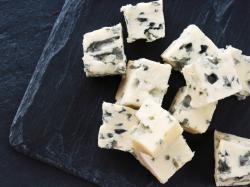What Kind Of Mold Is Okay On Cheese, And What Kind Isn’t?
April 27, 2018 | 2 min to read

We’ve all been there. You’re exploring the murky depths of your messy-ass fridge, sifting through treats and terrors in hopes of finding some suitable dinner material, when it appears: A hunk of cheese sporting a definitely-not-there-when-you-bought-it polka-dot coat of fuzzy mold. And then the bargaining begins. Moldy cheese, like all other moldy foods, should go in the garbage, you think to yourself quite reasonably. But then: Maybe that’s…okay? Like, blue cheese has mold on it, and that’s okay to eat, right? Can’t I just cut the gross-looking stuff off? Around and around we go, the menu for the evening oscillating between cheesy pasta—delicious, but maybe…deadly?—and some tired canned-bean business. This is exactly the kind of high-stakes negotiation that exactly no one has bandwidth for on a Tuesday night.
Enough! No more! There are answers to this whole is-moldy-cheese-safe business, and we must have them! We talked to Rich Morillo, a certified cheese professional (that’s a thing!) and the cheese operations manager (also a great title!) for Di Bruno Bros., Philadelphia's O.G. cheese shop—to find out what the deal is with moldy cheese and whether it belongs in the trash can or a baking dish. The answers? Kind of surprising, TBH.
The first thing you’ve got to understand is that, by and large, microorganisms like mold are what makes cheese, well, cheese. “In a lot of ways, cheese is mold,” explains Morillo. With the notable exception of fresh cheeses that are meant to be consumed shortly after they are made (mozzarella, ricotta, queso fresco, etc.), most cheeses owe their distinct deliciousness and texture to the microbiological alchemy that occurs when mold, bacteria, and other microorganisms feast on the proteins and sugars present in milk, transforming them into a wide range of flavorful compounds. (Science is cool!)
To read the rest of the story, please go to: Bon Appetit
